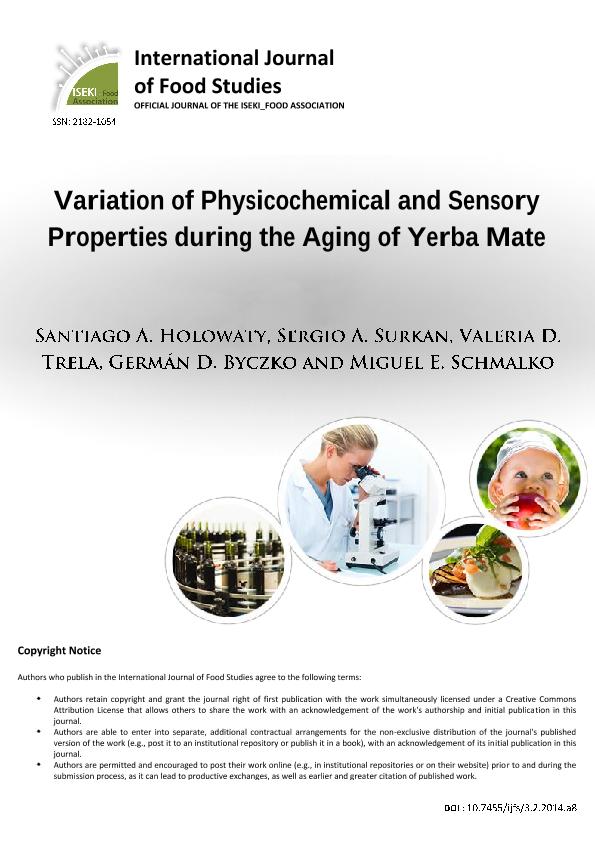Artículo
Variation of physicochemical and sensory properties during the aging of yerba mate
Holowaty, Santiago Alexi ; Surkan, Sergio A.; Trela, Valeria Daiana
; Surkan, Sergio A.; Trela, Valeria Daiana ; Byczko, German Dario; Schmalko Radichowski, Miguel Eduardo
; Byczko, German Dario; Schmalko Radichowski, Miguel Eduardo
 ; Surkan, Sergio A.; Trela, Valeria Daiana
; Surkan, Sergio A.; Trela, Valeria Daiana ; Byczko, German Dario; Schmalko Radichowski, Miguel Eduardo
; Byczko, German Dario; Schmalko Radichowski, Miguel Eduardo
Fecha de publicación:
02/2015
Editorial:
ISEKI Food Association
Revista:
International Journal of Food Studies
ISSN:
2182-1054
Idioma:
Inglés
Tipo de recurso:
Artículo publicado
Clasificación temática:
Resumen
Yerba mate infusion is widely consumed in Argentina, Brazil and Paraguay. One of the processing steps used in Argentina is aging. The following three methods are used to age yerba mate: 1) air humidity and temperature-controlled aging; 2) temperature-controlled aging and 3) no control. The aim of this research was to determine the physicochemical and sensory attribute differences when yerba mate is aged using these three methods. The concentration of caffeine, glucose, fructose, sucrose, maltose and phenolic compounds and pH generally diminish in all three aging methods but at different percentages. The sensory attributes did not exhibit a general behaviour. The astringent intensity remained constant in the first method and diminished in the other two. The bitter intensity increased in all three methods but at different percentages. The sweet intensity diminished in all three methods. Notably few correlations were determined between physicochemical and sensory attributes.
Palabras clave:
Ilex Paraguariensis
,
Yerba Mate
,
Sensory Evaluation
,
Chemical Compounds
,
Aging
Archivos asociados
Licencia
Identificadores
Colecciones
Articulos(CCT - NORDESTE)
Articulos de CTRO.CIENTIFICO TECNOL.CONICET - NORDESTE
Articulos de CTRO.CIENTIFICO TECNOL.CONICET - NORDESTE
Articulos(IMAM)
Articulos de INST.DE MATERIALES DE MISIONES
Articulos de INST.DE MATERIALES DE MISIONES
Citación
Holowaty, Santiago Alexi; Surkan, Sergio A.; Trela, Valeria Daiana; Byczko, German Dario; Schmalko Radichowski, Miguel Eduardo; Variation of physicochemical and sensory properties during the aging of yerba mate; ISEKI Food Association; International Journal of Food Studies; 3; 2; 2-2015; 228-238
Compartir
Altmétricas



